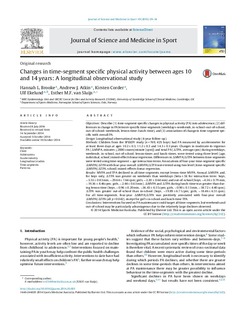| dc.description.abstract | Objectives: Describe (1) time-segment specific changes in physical activity (PA) into adolescence, (2) differences in change in PA between specific time-segments (weekdays–weekends, in-school–out-of-school, out-of-school–weekends, lesson-time–lunch-time), and (3) associations of change in time-segment specific with overall PA. Design: Longitudinal observational study (4-year follow-up). Methods: Children from the SPEEDY study (n = 769, 42% boys) had PA measured by accelerometer for at least three days at ages 10.2 ± 0.3, 11.2 ± 0.3 and 14.3 ± 0.3 years. Changes in moderate-to-vigorous PA (ΔMVPA, minutes ≥2000 counts/minute [cpm]) and total PA (ΔTPA, average cpm) during weekdays, weekends, in-school, out-of-school, lesson-times and lunch-times, were tested using three level (age, individual, school) mixed-effects linear regression. Differences in ΔMVPA/ΔTPA between time-segments were tested using time-segment × age interaction terms. Associations of four-year time-segment specific ΔMVPA/ΔTPA with four-year overall ΔMVPA/ΔTPA were tested using two level (time-segment specific ΔMVPA/ΔTPA, school) mixed-effects linear regression. Results: MVPA and TPA declined in all time-segments, except lesson-time MVPA. Annual ΔMVPA and, for boys only, ΔTPA was greater on weekends than weekdays (beta ± SE for interaction term: boys, −3.53 ± 0.83 min, −29.64 ± 7.64 cpm; girls, −2.20 ± 0.64 min) and out-of-school (boys, −4.36 ± 0.79 min, −19.36 ± 8.46 cpm; girls, −2.44 ± 0.63 min). ΔMVPA and ΔTPA during lunch-time was greater than during lesson-time (boys, −0.96 ± 0.20 min, −36.43 ± 6.55 cpm; girls, −0.90 ± 0.13 min, −38.72 ± 4.40 cpm). ΔTPA was greater out-of-school than in-school (boys, −19.89 ± 6.71 cpm; girls, −18.46 ± 6.51 cpm). For all time-segments, four-year ΔMVPA/ΔTPA was positively associated with four-year overall ΔMVPA/ΔTPA (all p < 0.042), except for girl's in-school and lunch-time TPA. Conclusions: Interventions focused on PA maintenance could target all time-segments, but weekends and out-of-school may be particularly advantageous due to the relatively large declines observed. | nb_NO |
